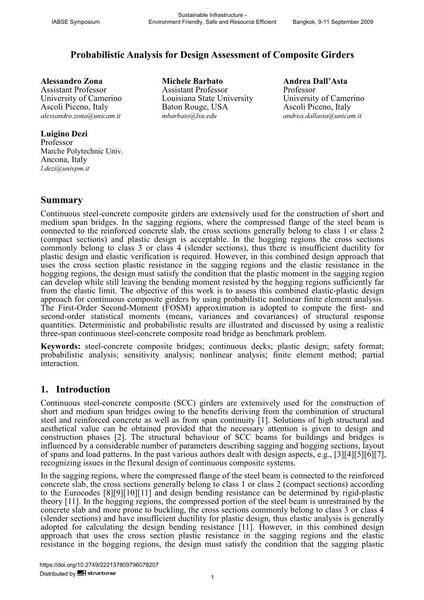Probabilistic Analysis for Design Assessment of Composite Girders

|
|
|||||||||||
Détails bibliographiques
| Auteur(s): |
Alessandro Zona
Michele Barbato Andrea Dall'Asta Luigino Dezi |
||||
|---|---|---|---|---|---|
| Médium: | papier de conférence | ||||
| Langue(s): | anglais | ||||
| Conférence: | IABSE Symposium: Sustainable Infrastructure - Environment Friendly, Safe and Resource Efficient, Bangkok, Thailand, 9-11 September 2009 | ||||
| Publié dans: | IABSE Symposium Bangkok 2009 | ||||
|
|||||
| Page(s): | 102-111 | ||||
| Nombre total de pages (du PDF): | 8 | ||||
| Année: | 2009 | ||||
| DOI: | 10.2749/222137809796078207 | ||||
| Abstrait: |
Continuous steel-concrete composite girders are extensively used for the construction of short and medium span bridges. In the sagging regions, where the compressed flange of the steel beam is connected to the reinforced concrete slab, the cross sections generally belong to class 1 or class 2 (compact sections) and plastic design is acceptable. In the hogging regions the cross sections commonly belong to class 3 or class 4 (slender sections), thus there is insufficient ductility for plastic design and elastic verification is required. However, in this combined design approach that uses the cross section plastic resistance in the sagging regions and the elastic resistance in the hogging regions, the design must satisfy the condition that the plastic moment in the sagging region can develop while still leaving the bending moment resisted by the hogging regions sufficiently far from the elastic limit. The objective of this work is to assess this combined elastic-plastic design approach for continuous composite girders by using probabilistic nonlinear finite element analysis. The First-Order Second-Moment (FOSM) approximation is adopted to compute the first- and second-order statistical moments (means, variances and covariances) of structural response quantities. Deterministic and probabilistic results are illustrated and discussed by using a realistic three-span continuous steel-concrete composite road bridge as benchmark problem. |
||||
| Mots-clé: |
ponts mixtes acier-béton
|
||||
